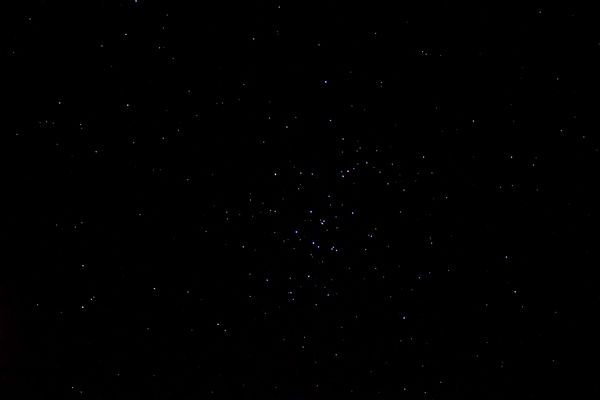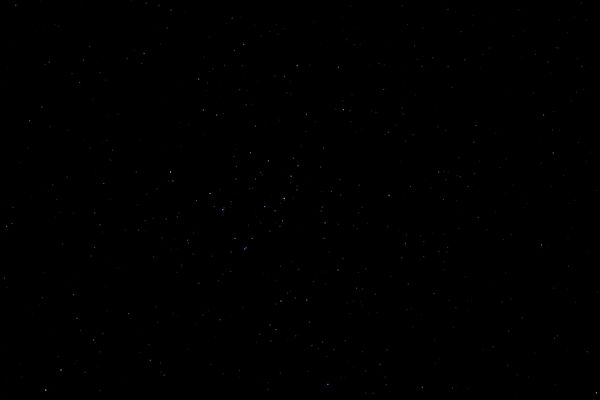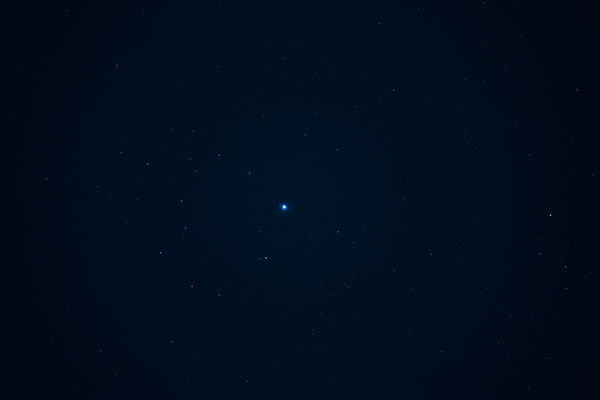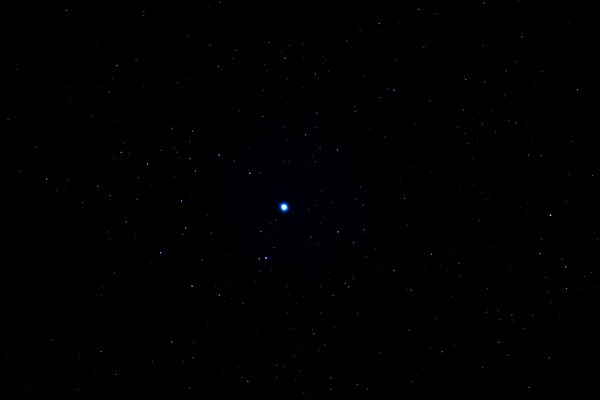Tamron 150-600 can be used for astrophotography
Apr 15, 2015 00:52:08 #
I wanted to convince myself that the Tamron 150-600mm lens was sharp enough to use for Astrophotography. Here is an image of the Beehive Cluster taken tonight. I did not get out the equatorial drive. Just mounted on the tripod.
This shot is at 600mm. Shot for 0.5 sec at F6.7 with an ISO of 12800 using a Sony A99 Full Frame camera. The camera actually used multi-frame noise reduction. A technique in which it fires 6 images and then combines them (like stacking) in camera to reduce noise.
At 600mm, about 0.5 sec was about the limit beyond which I got star trails.
Supposedly, there are about 75 stars in this star cluster and it looks like the camera must have picked up most of them.
My conclusion from this is that the Tamron is sharp enough to use for astrophotography. I tried it at 150mm and several spots inbetween and in all cases the image was sharp and stars remained pin points. I have had so issues using other zooms, but this Tamron is not showing any distortion. I see no Coma distortion at all.
The multi-frame noise removal made this image need very little post processing. Darkened the blacks in LR a bit, boosted clarity and whites. Also adjusted noise, but there was very little to remove.
Added a 2nd shot taken at 150mm, 3 sec at F4.5 and ISO of 12800 of an area with a number of stars just to show it also looks good.
This shot is at 600mm. Shot for 0.5 sec at F6.7 with an ISO of 12800 using a Sony A99 Full Frame camera. The camera actually used multi-frame noise reduction. A technique in which it fires 6 images and then combines them (like stacking) in camera to reduce noise.
At 600mm, about 0.5 sec was about the limit beyond which I got star trails.
Supposedly, there are about 75 stars in this star cluster and it looks like the camera must have picked up most of them.
My conclusion from this is that the Tamron is sharp enough to use for astrophotography. I tried it at 150mm and several spots inbetween and in all cases the image was sharp and stars remained pin points. I have had so issues using other zooms, but this Tamron is not showing any distortion. I see no Coma distortion at all.
The multi-frame noise removal made this image need very little post processing. Darkened the blacks in LR a bit, boosted clarity and whites. Also adjusted noise, but there was very little to remove.
Added a 2nd shot taken at 150mm, 3 sec at F4.5 and ISO of 12800 of an area with a number of stars just to show it also looks good.
Beehive Cluster at 600mm

(Download)
150mm shot of another spot in the sky just to prove no problem at the low end

(Download)
Apr 15, 2015 09:24:11 #
Well now, you know I'm going to just HAVE to try that Jim. :-D
Thanks for working out the numbers. ;)
(I still want a telescope though....) :lol:
In viewing the EXIF data I see where your white balance was set for "cloudy". Does that help bring out the stars?
I only ask because I'm trying to learn some of these finite control details.
And I'm still wondering if my D3300 can do an in camera combining. I still have to explore that.
Thanks for working out the numbers. ;)
(I still want a telescope though....) :lol:
In viewing the EXIF data I see where your white balance was set for "cloudy". Does that help bring out the stars?
I only ask because I'm trying to learn some of these finite control details.
And I'm still wondering if my D3300 can do an in camera combining. I still have to explore that.
Apr 15, 2015 11:19:46 #
SonnyE wrote:
Well now, you know I'm going to just HAVE to try that Jim. :-D
Thanks for working out the numbers. ;)
(I still want a telescope though....) :lol:
In viewing the EXIF data I see where your white balance was set for "cloudy". Does that help bring out the stars?
I only ask because I'm trying to learn some of these finite control details.
And I'm still wondering if my D3300 can do an in camera combining. I still have to explore that.
Thanks for working out the numbers. ;)
(I still want a telescope though....) :lol:
In viewing the EXIF data I see where your white balance was set for "cloudy". Does that help bring out the stars?
I only ask because I'm trying to learn some of these finite control details.
And I'm still wondering if my D3300 can do an in camera combining. I still have to explore that.
I have been trying both cloudy and a temperature of 2500 Kelvin which is more to the red. And it seems it has some merit.
Your camera may not have the multi-frame noise reduction. It is a really nice feature in that I can elect to let the camera do it rather than doing it myself, as long as I am satisfied with a final JPG image, that is. If I am doing stars only, it is really good. But for things like nebula and galaxies, faint detail is going to be thrown away.
But as you can see, I pushed this to ISO 12800. And with the 6 frames the camera stacked, most of the noise was gone. I really had very little left to do by the time this image was pulled into lightroom. The sky had been darkened in the stacking process, and I just made it a little darker. And I boosted the whites to bring out the stars.
But the sharpness of the stars was what I was really looking at. This means I can set up the equatorial drive and use this lens and pull in a lot of light. In another post, I used my 300mm F2.8 on the equatorial drive and was able to pull in the Dumbbell Nebula.
I also have my 8" reflector. But I like to experiment and try out camera lenses too. When I retire, and don't need to be getting up for work at 5AM, I will do this more often.
I might add that the Sony A99, 24M full crop, can do this at ISO 12800 and average out the noise. I have tried at 25600, but I ended up with more noise.
I have the Sony A57, 16M APS-C, and it's noise is a bit higher and I can push it to about ISO 6400 using the same multi-frame noise reduction.
I also have the Sony A6000, but I find it's noise level is higher than the A57. It also can do the multi-frame noise reduction.
I also have the Sony A55 which has been modified for IR. It does not have multi-frame noise reduction. But the sky is not as light polluted in the IR spectrum.
Apr 15, 2015 14:03:12 #
Mine probably can't do that. I'm a bottom dweller as far as my camera goes. ;) :lol:
But it does have a 24+ MPX sensor. +
And I can do a burst mode. +
So maybe, if I could do a burst of 5-10 frames, then stack them,
Maybe....
I have tried a few evenings of dabbling with the Big Tammy.
And believe me, I have entertained just getting an AVX and trying mounting the Camera/Tamron to do some shooting.
But figure I should wait and get a scope with.
Anyway, when the Great Day comes, I plan on trying the camera directly on the mount.
I could go with Orion's little camera bundle, but I don't want to get stuck there. I want a real mount, and a real telescope. So I keep biting my tongue... :lol:
It could be a good alternative for many aspiring Astrophotographer's though....
In the past several days I've been experimenting with Time Lapsed, then making video's. A bit crude so far, but a fun variation on star trails. :)
Please keep the great idea's coming for us sitting on the edge of our seats. ;)
But it does have a 24+ MPX sensor. +
And I can do a burst mode. +
So maybe, if I could do a burst of 5-10 frames, then stack them,
Maybe....
I have tried a few evenings of dabbling with the Big Tammy.
And believe me, I have entertained just getting an AVX and trying mounting the Camera/Tamron to do some shooting.
But figure I should wait and get a scope with.
Anyway, when the Great Day comes, I plan on trying the camera directly on the mount.
I could go with Orion's little camera bundle, but I don't want to get stuck there. I want a real mount, and a real telescope. So I keep biting my tongue... :lol:
It could be a good alternative for many aspiring Astrophotographer's though....
In the past several days I've been experimenting with Time Lapsed, then making video's. A bit crude so far, but a fun variation on star trails. :)
Please keep the great idea's coming for us sitting on the edge of our seats. ;)
Apr 15, 2015 14:16:26 #
SonnyE wrote:
Mine probably can't do that. I'm a bottom dweller ... (show quote)
Yes, there no reason you can't just stack in your computer. I have to do that if I want to use RAW which is preferable for nebula and galaxies anyway.
As you saw, I could only shoot 1/2 sec at 600mm. I extended that to 3 sec at 150mm.
Before you get a scope, learn the noise your camera will generate and how to remove it. Push the ISO and see what it can do. And then how good you can get at removing it. I love the look that comes with stars against a black sky. When the noise shows through, it really impacts the overall look.
There is controversy over how the Sony A99 stands up against the big boys such as Nikon's D800 and Canon's equivalent. But the difference must be tiny as I am continually getting clean looking images to work with.
Apr 15, 2015 14:41:08 #
SonnyE wrote:
Mine probably can't do that. I'm a bottom dweller ... (show quote)
I might mention that I bought my mount and scope separately. It is easy to mount the camera plus lens instead of the scope. The mount accepts a dovetail type mounting block for a secure attachment. So all you need is a setarate dovetail adapter that has the 1/4 inch mounting screw on top. They can be found on eBay. My dovetail adapter is probaby 6 or 7 inches long and perhaps 1/2 in thick. It attaches to the mount exactly like the scope would do.
I might add that it is best to mount the scope in daylight. The scope is big and heavy and I have to wrap my arms around it and fit the dovetail into the slot and then tighten it up. I wouldn't want to do this in the dark.
Apr 15, 2015 14:53:37 #
JimH123 wrote:
I might mention that I bought my mount and scope s... (show quote)
I looked at the mount you mentioned above. It would max out with just a camera plus lens.
I have Celestron CG5 which I bought marked down to just over $500. I am near maxed out on it. My scope with camera is in excess of 22 pounds. I place 23 pounds of counter weights on it. The tripod alone in close to 50 pounds. It is very stable.
Apr 15, 2015 16:25:15 #
SonnyE wrote:
I could go with Orion's little camera bundle, but I don't want to get stuck there. I want a real mount, and a real telescope. So I keep biting my tongue... :lol:
Please keep the great idea's coming for us sitting on the edge of our seats. ;)
I could go with Orion's little camera bundle, but I don't want to get stuck there. I want a real mount, and a real telescope. So I keep biting my tongue... :lol:
Please keep the great idea's coming for us sitting on the edge of our seats. ;)
I have this mount and it's not worth the money. It did not do well with my Canon and the 300mm L lens. I had nasty commas everywhere due to slippage. If you don't watch the mount and let it run, it will swing into the direction controls because it is just not built correctly.
I never use it and wouldn't burden anyone else with it.
I thought I had written a poor review for it on the Orion site but it appears to no longer be there.
Save for a better tripod/mount Sonny.
Apr 15, 2015 19:44:19 #
JimH123 wrote:
I wanted to convince myself that the Tamron 150-60... (show quote)
Nice job Jim I love that Lens.
Craig
Apr 16, 2015 01:29:48 #
I am adding another shot taken tonight to again show what the Tamron lens can do. Put it on a fixed tripod and aimed at Polaris. Took a 20 sec shot in RAW at ISO 1600 F6.7. I thought it was at 600mm, but after coming in, I looked at the EXIF info and saw I was only at 560mm. Didn't turn it quite far enough.
If you look at Polaris, you will see a trail of star going down diagonally. You will need to download and click again to blow it up. There is a bright, then a dim, then a bright, and then a dim. According to Starry Night, the first dim star is at magnitude 16.25.
The first shot is the original out of the camera. A single shot in RAW at ISO 1600 for 20sec, 560mm f6.7. (At 30 sec, I could see tiny star trails). I provided this to see how the noise looked at ISO 1600 for 20 sec.
The next shot is the same image after processing.
According to Starry Night, Polaris is a double star with a magnitude 9.1 companion only 18.8 arc sec from Polaris. I do not see that double being resolved. Need a bigger scope than the Tamron lens for that.
If you look at Polaris, you will see a trail of star going down diagonally. You will need to download and click again to blow it up. There is a bright, then a dim, then a bright, and then a dim. According to Starry Night, the first dim star is at magnitude 16.25.
The first shot is the original out of the camera. A single shot in RAW at ISO 1600 for 20sec, 560mm f6.7. (At 30 sec, I could see tiny star trails). I provided this to see how the noise looked at ISO 1600 for 20 sec.
The next shot is the same image after processing.
According to Starry Night, Polaris is a double star with a magnitude 9.1 companion only 18.8 arc sec from Polaris. I do not see that double being resolved. Need a bigger scope than the Tamron lens for that.
Original, no processing. RAW @ ISO 1600 for 20 sec, 560mm F6.7

(Download)
Processed version

(Download)
Apr 16, 2015 08:58:32 #
You seem to see a lot more stars there than I can in my light polluted back yard. :hunf: :mrgreen:
I went out and shot some quick and dirty pictures last night to play with. Using live view I was able to get some pretty decent focus, for me.
But not Polaris this time. Just picked a bright star and rattled off 33 exposures. Did some continuous release shooting, and single shots.
But no time to play much. Going out of town this weekend.
To a much worse light polluted den of foolishness.
Sackramento.
If Hillary gets the Presidency, I'll be taking pictures in Canada. :roll:
I went out and shot some quick and dirty pictures last night to play with. Using live view I was able to get some pretty decent focus, for me.
But not Polaris this time. Just picked a bright star and rattled off 33 exposures. Did some continuous release shooting, and single shots.
But no time to play much. Going out of town this weekend.
To a much worse light polluted den of foolishness.
Sackramento.
If Hillary gets the Presidency, I'll be taking pictures in Canada. :roll:
Apr 16, 2015 10:26:23 #
SonnyE wrote:
You seem to see a lot more stars there than I can ... (show quote)
I picked Polaris because it moves slower and I can expose for a longer anount of time. I did some multi-frame noise reduction shots and some RAW. I even tried ISO as high as 51000. Even with multi-frame noise reduction, the image was too degraded to show more detail. Eventually decided I was getting the best image in RAW at ISO 1600.
I want to try stacking next. I downloaded Deep Sky Stacker and it is crashing when I try to use it. Maybe I downloaded a beta version that wasn't quite ready for prime time.
From Morgan Hill, my sky is darker than nearby San Jose. But it is still bright.
Apr 16, 2015 12:41:41 #
JimH123 wrote:
I am adding another shot taken tonight to again sh... (show quote)
Once again real fine job Jim. That lens will never stop amazing you.
Craig
Apr 17, 2015 13:45:04 #
SonnyE wrote:
Mine probably can't do that. I'm a bottom dweller ... (show quote)
Sonny if you're going to make a 1 time purchase at a very reasonable price.
Check this link. I think you'll fall in love. What ever you do I would recommend the AVX Mount.
It's as simple or as complex as you can handle. You can PM Jim (Albuqshutterbug) he got the same outfit.
celestron.com/browse-shop/astronomy/telescopes/advanced-vx-6-schmidt-cassegrain-telescope.
The light is green :mrgreen: pull the trigger. If you have more questions please PM me too.
Craig
Apr 17, 2015 14:24:10 #
CraigFair wrote:
Sonny if you're going to make a 1 time purchase at a very reasonable price.
Check this link. I think you'll fall in love. What ever you do I would recommend the AVX Mount.
It's as simple or as complex as you can handle. You can PM Jim (Albuqshutterbug) he got the same outfit.
http://www.celestron.com/browse-shop/astronomy/telescopes/advanced-vx-6-schmidt-cassegrain-telescope.
The light is green :mrgreen: pull the trigger. If you have more questions please PM me too.
Craig
Check this link. I think you'll fall in love. What ever you do I would recommend the AVX Mount.
It's as simple or as complex as you can handle. You can PM Jim (Albuqshutterbug) he got the same outfit.
http://www.celestron.com/browse-shop/astronomy/telescopes/advanced-vx-6-schmidt-cassegrain-telescope.
The light is green :mrgreen: pull the trigger. If you have more questions please PM me too.
Craig
Craig,
The URL is missing some stuff at the end.
And by the way, I have the predecessor to the AVX which is called CG5. It is discontinued now, but also works well. Sometimes you can find it cheaper than the AVX.
Some extras I bought to use with it:
1) Polar Scope to make polar alignment easier. My 65 year old eyes had trouble looking though the opening and to actually see Polaris. (Maybe its my progressive lenses when get down low enough to see through it?). And with the scople, it has engraved a circle on which Polaris is going to sit and I rotate the scope to make it line up with the big dipper or Cassiopeia, whichever I can see and it shows me where on the circle Polaris should be. And when I carefully do this, my polar alignment seems to be right on.
2) An extra 11.5 pound weight. It is important to balance the scope with the weights and my scope plus camera was too heavy to do a balance, even with the weight all the way to the end. So now I use 2 weights and balancing is no problem.
3) A lead acid 12V battery to drive it while outside. COSTCO and HarborFreight Tools carry nice ones. I have the HarborFreight Tools version and it has 2 automotive type cigaret lighter connectors on it and one I plug in the drive and the other, I plug in a external LCD monitor. I find it is a pain to actually see the LCD on the camera and I watch what I am doing from the external LCD monitor.
There is other software that can be used to control the drive with a laptop, but haven't purchased it yet. I am simply using the hand control that came with the mount. There are supposedly 40,000 things in the database.
To align, you need to pick out from a list several stars you wish to use and then you can do a finer tuning using a couple more stars. I have found that once I do the align, that whatever I go to is right in the center of the display every time.
If you want to reply, then register here. Registration is free and your account is created instantly, so you can post right away.


